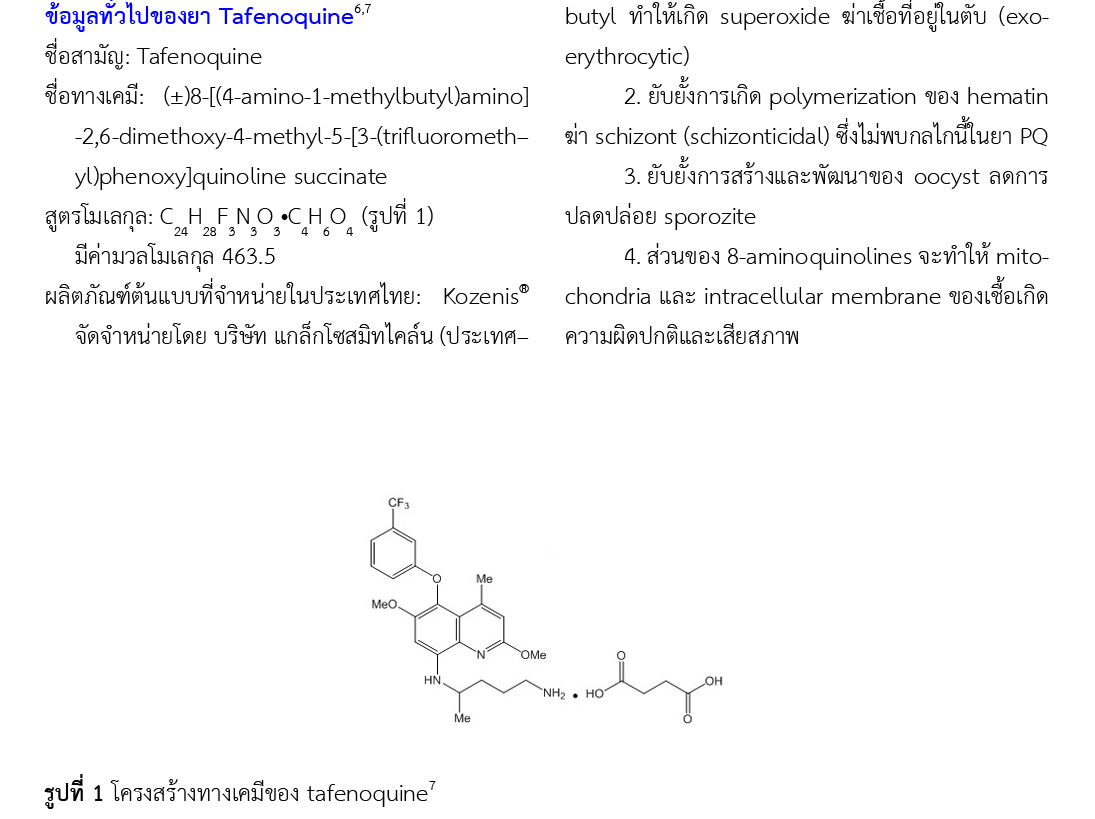Tafenoquine ในการป้องกันการกลับเป็นซ้ำของไข้มาลาเรียชนิด Plasmodium vivax
คำสำคัญ:
Tafenoquine, ยารักษาโรคไข้มาลาเรีย, ยาป้องกันการกลับเป็นซ้ำของโรคไข้มาลาเรีย, P. vivaxบทคัดย่อ
ยา tafenoquine เป็นอนุพันธ์ของยา primaquine ซึ่งอยู่ในกลุ่ม 8-aminoquinolines ได้รับการอนุมัติจากคณะกรรมการอาหารและยาของประเทศไทย เมื่อวันที่ 27 ธันวาคม พ.ศ. 2562 ในข้อบ่งใช้ป้องกันการกลับเป็นซ้ำของโรคไข้มาลาเรียชนิด Plasmodium vivax ในผู้ที่อายุ 16 ปีขึ้นไป (รักษาโรคไข้มาลาเรียจากการติดเชื้อ P. vivax ให้หายขาด) ขนาดยาที่ใช้คือ 300 มิลลิกรัม ครั้งเดียว โดยให้ยาในวันที่ 1 หรือ วันที่ 2 พร้อมกับยา chloroquine เนื่องจากตัวยามีคุณสมบัติกระตุ้นให้เม็ดเลือดแดงแตกได้ในผู้ที่มีภาวะพร่องเอนไซม์ glucose-6-phosphate dehy–drogenase (G6PD) ก่อนเริ่มใช้ยาผู้ป่วยจึงต้องตรวจระดับเอนไซม์ G6PD เชิงปริมาณก่อน สำหรับอาการไม่พึงประสงค์ทั่วไปที่พบได้จากยา tafenoquine ได้แก่ มึนงง คลื่นไส้ อาเจียน ปวดศีรษะ รายงานการศึกษาพบว่ายา tafenoquine มีประสิทธิภาพ และความปลอดภัยไม่แตกต่างกับการให้ primaquine 15 มิลลิกรัม วันละครั้งติดต่อกันเป็นเวลา 14 วัน แต่สะดวกในการบริหารยามากกว่า
เอกสารอ้างอิง
สำนักสื่อสารความเสี่ยงและพัฒนาพฤติกรรมสุขภาพ[อินเตอร์เน็ต]. นนทบุรี: กรมควบคุมโรค กระทรวงสาธารณสุข; 2562 [เข้าถึงเมื่อ 6 ตุลาคม 2563]. เข้าถึงได้จาก: https://ddc.moph.go.th/brc/news.php?news=14793&deptcode=brc&news_views=3821.
กรมควบคุมโรค กระทรวงสาธารณสุข. แนวทางเวชปฏิบัติในการรักษาผู้ป่วยโรคไข้มาลาเรียประเทศไทย พ.ศ. 2562. นนทบุรี. ชุมนุมสหกรณ์การเกษตรแห่งประเทศไทย จำกัด; 2563.
Tan KR, Hwang J. Tafenoquine receives regulatory approval in USA for prophylaxis of malaria and radical cure of Plasmodium vivax. J Travel Med. 2018;25(1):1-2.
DRUGDEX [database on the Internet]. Greenwood Village (CO): IBM Corporation; 2017 [cited 2020 Dec 5]. Available from: www.micromedexsolutions.com. Subscription required to view.
Centers for Disease Control and Prevention. Clinical update tafenoquine approved for malaria prophylaxis and treatment [Internet]. 2003 [cited 2021 Apr 4]. Available from: https://wwwnc.cdc.gov/travel/news-announcements/tafenoquine-malaria-prophylaxis-and-treatment.
สำนักงานคณะกรรมการอาหารและยา. ตรวจสอบการอนุญาต-ข้อมูลผลิตภัณฑ์[อินเตอร์เน็ต]. นนทบุรี: กระทรวงสาธารณสุข; 2562 [เข้าถึงเมื่อ 4 เมษายน 2564]. เข้าถึงได้จาก: http://pertento.fda.moph.go.th/FDA_SEARCH_DRUG/SEARCH_DRUG/pop-up_drug_ex.aspx?Newcode=U1DR1C1012620004511C.
Krintafel (tafenoquine succinate tablets) [package insert].Upper Providence (PA):GlaxoSmithKline Research & Development Ltd;2018.
Ebstie YA, Abay SM, Tadesse WT, Ejigu DA. Tafenoquine and its potential in the treatment and relapse prevention of Plasmodium vivax malaria: the evidence to date. Drug Des Devel Ther. 2016;10:2387-99.
Crockett M, Kain KC. Tafenoquine: a promising new antimalarial agent. Expert Opin Investig Drugs. 2007;16(5):705-15.
Lima Jr JC, Pratt-Riccio LR. Major histocompatibility complex and malaria: focus on Plasmodium vivax Infection. Front Immunol. 2016;7(13):1-14.
Thakkar N, Green JA, Koh GCKW, Duparc S, Tenero D, Goyal N. Population pharmacokinetics of tafenoquine, a novel antimalarial. Antimicrob Agents Chemother. 2018;62(11):e00711-18.
Edstein MD, Kocisko DA, Walsh DS, Eamsila C, Charles BG, Rieckmann KH. Plasma concentrations of tafenoquine, a new long-acting antimalarial agent, in Thai soldiers receiving monthly prophylaxis. Clin Infect Dis. 2003;37(12):1654-8.
Green JA, Mohamed K, Goyal N, Bouhired S, Hussaini A, Jones SW, et al. Pharmacokinetic interactions between tafenoquine and dihydroartemisinin-piperaquine or artemether-lumefantrine in healthy adult subjects. Antimicrob Agents Chemother. 2016;60(12):7321-32.
Miller AK, Harrell E, Ye L, Baptiste-Brown S, Kleim JP, Ohrt C, et al. Pharmacokinetic interactions and safety evaluations of coadministered tafenoquine and chloroquine in healthy subjects. Br J Clin Pharmacol. 2013;76(6):858-67.
Walsh DS, Wilairatana P, Tang DB, Heppner DG Jr, Brewer TG, Krudsood S, et al. Randomized trial of 3-dose regimens of tafenoquine (WR238605) versus low-dose primaquine for preventing Plasmodium vivax malaria relapse. Clin Infect Dis. 2004;39(8):1095-103.
Llanos-Cuentas A, Lacerda MV, Rueangweerayut R, Krudsood S, Gupta SK, Kochar SK, et al. Tafenoquine plus chloroquine for the treatment and relapse prevention of Plasmodium vivax malaria (DETECTIVE): a multicentre, double-blind, randomised, phase 2b dose-selection study. Lancet. 2014;383(9922):1049-58.
Beck HP, Wampfler R, Carter N, Koh G, Osorio L, Rueangweerayut R, et al. Estimation of the antirelapse efficacy of tafenoquine, using Plasmodium vivax genotyping. J Infect Dis. 2016;213(5):794-9.
Fukuda MM, Krudsood S, Mohamed K, Green JA, Warrasak S, Noedl H, et al. A randomized, double-blind, active-control trial to evaluate the efficacy and safety of a three day course of tafenoquine monotherapy for the treatment of Plasmodium vivax malaria. PloS One.2017;12(11):e0187376.
Lacerda MVG, Llanos-Cuentas A, Krudsood S, Lon C, Saunders DL, Mohammed R, et al. Single-dose tafenoquine to prevent relapse of Plasmodium vivax malaria. N Engl J Med. 2019;380(3):215-28.
Llanos-Cuentas A, Lacerda MG, Hien TT, Velez ID, Namaik-Larp C, Chu CS, et al. Tafenoquine versus primaquine to prevent relapse of Plasmodium vivax malaria. N Engl J Med. 2019;380(3):229-41.
Centers for Disease Control and Prevention. Treatment of malaria: guidelines for clinicians (United States) [Internet]. 2003 [cited 2020 Oct 6]. Available from: https://www.cdc.gov/malaria/resources/pdf/Malaria_Treatment_Guidelines.pdf.

ดาวน์โหลด
เผยแพร่แล้ว
รูปแบบการอ้างอิง
ฉบับ
ประเภทบทความ
สัญญาอนุญาต
ข้อความภายในบทความที่ตีพิมพ์ในวารสารเภสัชกรรมโรงพยาบาลทั้งหมด รวมถึงรูปภาพประกอบ ตาราง เป็นลิขสิทธิ์ของสมาคมเภสัชกรรมโรงพยาบาล (ประเทศไทย) การนำเนื้อหา ข้อความหรือข้อคิดเห็น รูปภาพ ตาราง ของบทความไปจัดพิมพ์เผยแพร่ในรูปแบบต่าง ๆ เพื่อใช้ประโยชน์ในเชิงพาณิชย์ ต้องได้รับอนุญาตจากกองบรรณาธิการวารสาร (สมาคมเภสัชกรรมโรงพยาบาล (ประเทศไทย)) อย่างเป็นลายลักษณ์อักษร
สมาคมเภสัชกรรมโรงพยาบาล (ประเทศไทย) อนุญาตให้สามารถนำไฟล์บทความไปใช้ประโยชน์และเผยแพร่ต่อได้ โดยอยู่ภายใต้เงื่อนไขสัญญาอนุญาตครีเอทีฟคอมมอน (Creative Commons License: CC) โดย ต้องแสดงที่มาจากวารสาร – ไม่ใช้เพื่อการค้า – ห้ามแก้ไขดัดแปลง, Attribution-NonCommercial-NoDerivatives 4.0 International (CC BY-NC-ND 4.0)
ข้อความที่ปรากฏในบทความในวารสารเป็นความคิดเห็นส่วนตัวของผู้เขียนแต่ละท่านไม่เกี่ยวข้องกับสมาคมเภสัชกรรมโรงพยาบาล (ประเทศไทย) และบุคลากรในสมาคมฯ แต่อย่างใด ความรับผิดชอบองค์ประกอบทั้งหมดของบทความแต่ละเรื่องเป็นของผู้เขียนแต่ละท่าน หากมีความผิดพลาดใด ๆ ผู้เขียนแต่ละท่านจะรับผิดชอบบทความของตนเอง ตลอดจนความรับผิดชอบด้านเนื้อหาและการตรวจร่างบทความเป็นของผู้เขียน ไม่เกี่ยวข้องกับกองบรรณาธิการ


.png)

